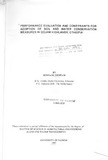| dc.description.abstract | Data on rainfall, runoff, soil loss, crop yield and land use have been collected from Anjeni soil
conservation research unit since 1984, in order to evaluate the performance of different soil and
water conservation measures on runoff, soil loss and crop yield and based on these, to identify
the most suitable soil conservation measure(s) for the study area and other areas having similar
environmental conditions. The experimental treatments evaluated were: grass strip, graded bund,
graded fanya juu and traditional farming (control plot). The experiments were carried out on 6 m
x 30-m plots located in two sites with different slope (28 % and 12 %). However, despite such
an amount of input in terms of labour, time and money, this raw data had not been analyzed. The
first part of this study aimed at analyzing this data in order to evaluate the performance of these
treatments in minimizing soil loss and runoff The second part of the study assessed the
opportunities and constraints for the adoption of soil and water conservation measures in Gojam
Highlands.
The result showed that the highest mean annual runoff (501.3 mm, 30.6% of the mean annual
rainfall) and soil loss (122.1 t/ha) was measured on traditional farming (control plot) in
experimental plot I (28% slope). The lowest mean annual runoff (275.3 mm, 16.8% of the mean
annual rainfall) and soil loss (30.3 t/ha) in this plot was measured on the grass strip. In
experimental plot II (12% slope), the highest mean annual runoff(451.5 mm, 27.5% of the mean
annual rainfall) and soil loss (88.2 t/ha) was measured on the traditional farming. The lowest
mean annual runoff (263.6 mm, 16.1% of the mean annual rainfall) and soil loss (25.6 t/ha) in
this experimental plot was measured on graded fanya juu. However, no clear difference had been
observed on crop yield between treatments at both sites. Statistical analysis showed that all the
soil conservation structures investigated except traditional farming (control plot) are effective in
controlling soil erosion on the steeper landscapes (EP I), while at lower slope (EP II) only
graded fanya juu was found to be effective in reducing runoff and soil loss when compared with
the control plots.
A questionnaire survey was carried out in Gojam highlands, Ethiopia. It covered four agroclimatic
zones, namely Wurch, Dega, Weyna Dega and Kolla. These zones are located at
different altitude, topography and farming systems. Ten households were interviewed at each
agro-climatic zone. The study revealed that most of the soil and water conservation work has
been destroyed or modified by the farmers to suit local conditions at higher altitude (> 2300 m
asl).
In Wurch zone, 30, 10 and 60% of the respondents indicated that the output (crop yield) of soil
and water conservation measures was high, low and insignificant respectively. In Dega zone, 50,
10 and 40% of the respondents indicated that the output of soil and water conservation
measures was high, low, and insignificant respectively. In Weyna Dega zone all the respondents
said the output of soil and water conservation measure (traditional ditches) was high. In Kolla
zone, 90 and 10% of the respondents indicated that the output was high and insignificant
respectively. | en |

